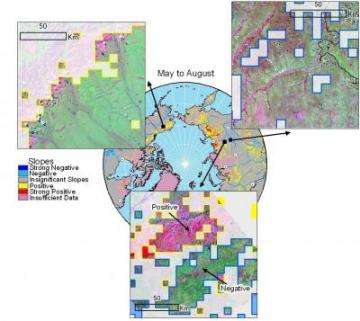This map shows characteristic trend patterns in photosynthetic activity for different land cover types. Areas with significant trends are showing through while insignificant trends are opaque. The trends are colored according to magnitude of the greening or browning. The upper left image shows the widespread greening occurring on the tundra areas north of the Brooks Range in Alaska (the mountains themselves show no significant trends). The upper right subset shows negative trends in the interior forests of Russia, while the bottom image shows a transition from positive to negative trends as a boundary from forest to wetlands is crossed. Credit: A. Bunn/S. Goetz. Woods Hole Research Center.
Using time series analyses of a 22-year record of satellite observations across the northern circumpolar high latitudes, scientists at the Woods Hole Research Center are assessing trends in vegetation photosynthetic activity. The results indicate that tundra areas consistently and predominantly show greening trends while forested areas show browning, indicating that the boreal forest biome might be responding to climate change in previously unexpected ways. This research is highlighted in the current issue of Earth Interactions.
According to Andrew Bunn, lead author of the paper and a post-doctoral fellow at the Center, "This research suggests that the high latitudes might not be responding to climate change as previously thought. If the ability of boreal forests to capture and store carbon in a warmer world is not as great as we've previously supposed, then we will have to think differently about how the planet will respond to continuing emissions of carbon dioxide."
All land surfaces above 50° N, excluding the glaciers of Greenland, were included in this study. Growing seasons were defined as May to August though early and late growing season periods were also considered. Three primary data sets derived from polar-orbiting satellites were used.
Overall, tundra areas show marked greening over the entire growing season. These patterns were consistent with relatively simple climate response seen in related work in North America, where areas responded to summer maximum temperatures while the response of forest vegetation was more complex. Boreal forests patterns indicate significant greening in May and June, with gains offset by substantive browning in July and August.
These results illustrate a need for an expanded observational network, additional analysis of existing data sets, including tree rings, and improvements in process models of ecosystem responses to climate change.
According to Scott Goetz, a senior scientist at the Center and co-author of the paper, "This work extends our previous analyses by specifically considering issues of vegetation type and density over this vast region, as well as differences in seasonality of photosynthetic gains and losses. Rather than a systematic greening of high latitudes with warmer temperature, we are seeing a more nuanced and surprisingly rapid response to changes in climate. What we'd like to know is whether these trends will continue to result in forest decline, exacerbating the impact of warming, or will the forests somehow be able to adapt? Models can tell us what is likely to occur, but we are most anxious to see what the satellite observations will reveal over the next few years."
Dr. Bunn is an ecologist interested in understanding climate change impacts on the biosphere. He is particularly interested in understanding the natural range of climate variability over the last two thousand years using natural archives of past temperature and precipitation derived from tree rings. He was awarded a Canon National Parks Science Scholarship in 2001 for work combining tree rings, remote sensing, and computer simulations of high elevation forests in Sequoia National Park. He earned a master's degree from Duke University and a doctorate from Montana State University.
Dr. Goetz works on the application of satellite imagery to analyses of environmental change, including monitoring and modeling links between land use change, forest productivity, biodiversity, climate, and human health.
Source: Woods Hole Research Center
























